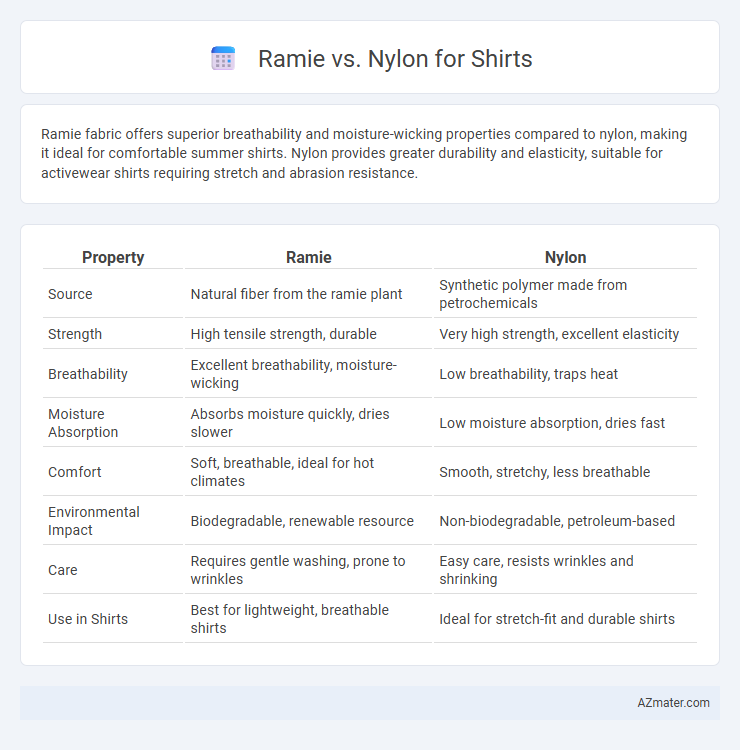Ramie fabric offers superior breathability and moisture-wicking properties compared to nylon, making it ideal for comfortable summer shirts. Nylon provides greater durability and elasticity, suitable for activewear shirts requiring stretch and abrasion resistance.
Table of Comparison
| Property | Ramie | Nylon |
|---|---|---|
| Source | Natural fiber from the ramie plant | Synthetic polymer made from petrochemicals |
| Strength | High tensile strength, durable | Very high strength, excellent elasticity |
| Breathability | Excellent breathability, moisture-wicking | Low breathability, traps heat |
| Moisture Absorption | Absorbs moisture quickly, dries slower | Low moisture absorption, dries fast |
| Comfort | Soft, breathable, ideal for hot climates | Smooth, stretchy, less breathable |
| Environmental Impact | Biodegradable, renewable resource | Non-biodegradable, petroleum-based |
| Care | Requires gentle washing, prone to wrinkles | Easy care, resists wrinkles and shrinking |
| Use in Shirts | Best for lightweight, breathable shirts | Ideal for stretch-fit and durable shirts |
Introduction to Ramie and Nylon Fabrics
Ramie is a natural fiber derived from the stalks of the Chinese nettle plant, valued for its lustrous appearance, durability, and moisture-wicking properties, making it an eco-friendly option for breathable shirts. Nylon, a synthetic polymer made from petrochemicals, offers exceptional strength, elasticity, and resistance to abrasion and wrinkles, ideal for performance and activewear shirts. Both fabrics present distinctive benefits in shirt manufacturing, with Ramie excelling in comfort and environmental sustainability, while Nylon delivers enhanced durability and stretch.
Origins and History of Ramie and Nylon
Ramie, one of the oldest natural fibers, originates from the stalks of the Chinese nettle plant with roots tracing back over 5,000 years to ancient China, where it was prized for its durability and lustrous appearance. Nylon, a synthetic polymer developed in 1935 by Wallace Carothers at DuPont, revolutionized textiles by offering a strong, elastic alternative to natural fibers, initially gaining fame in the production of hosiery and parachutes during World War II. The historical significance of ramie lies in its natural, biodegradable properties and traditional cultivation methods, while nylon's origin marks the advent of modern industrial fiber manufacturing and widespread use in performance apparel.
Material Composition and Fabric Structure
Ramie fabric, derived from the natural fibers of the Chinese nettle plant, features a bast fiber structure known for breathability and moisture absorption, making it ideal for lightweight, summer shirts. Nylon, a synthetic polymer fiber, offers a smooth, tightly knit structure that provides durability, elasticity, and resistance to wrinkles and abrasion, often used in performance or activewear shirts. The contrasting material composition between ramie's natural cellulose-based fibers and nylon's synthetic polyamide molecules significantly affects fabric texture, comfort, and maintenance requirements.
Breathability and Comfort Comparison
Ramie fabric offers superior breathability compared to nylon, making it an ideal choice for shirts worn in warm climates due to its natural moisture-wicking properties and lightweight texture. Nylon, while durable and resistant to wrinkles, tends to trap heat and moisture, reducing overall comfort during prolonged wear. The natural fibers in ramie provide enhanced ventilation and softness, promoting skin comfort and preventing irritation often associated with synthetic nylon fabrics.
Moisture Absorption and Quick-Drying Properties
Ramie fabric boasts superior moisture absorption, absorbing nearly 30% more water than nylon, which helps keep the skin dry and comfortable during heat exposure. Nylon, however, excels in quick-drying properties due to its synthetic fiber structure, making shirts made from it ideal for rapid moisture evaporation. Choosing between ramie and nylon depends on whether comfort through moisture absorption or fast drying is prioritized for active or casual wear.
Durability and Wear Resistance
Ramie fibers exhibit exceptional durability due to their natural resistance to stretching and tearing, making them ideal for shirts requiring long-lasting wear. Nylon offers superior wear resistance with high tensile strength and excellent abrasion resistance, ensuring shirts maintain shape and withstand frequent use. When comparing durability, nylon generally outperforms ramie in resistance to wear and repetitive stress, but ramie provides a more breathable and eco-friendly option.
Environmental Impact and Sustainability
Ramie is a natural fiber derived from the stalks of the Chinese nettle plant, making it biodegradable and renewable with low environmental impact due to minimal pesticide use and water consumption. Nylon, a synthetic polymer made from petrochemicals, has a significant carbon footprint, relies on non-renewable resources, and contributes to microplastic pollution during washing. Choosing ramie over nylon for shirts supports sustainability by reducing reliance on fossil fuels and enhancing biodegradability in textile production.
Care, Maintenance, and Longevity
Ramie shirts require gentle washing and air drying to maintain their natural fibers, as harsh detergents and high heat can weaken the fabric and cause shrinkage. Nylon shirts offer superior durability and are easier to care for, with resistance to wrinkles, stains, and stretching, allowing for machine washing and quick drying without significant loss of shape or color. Over time, nylon maintains its strength and appearance better than ramie, making it a longer-lasting option for everyday wear.
Applications of Ramie and Nylon in Shirts
Ramie fabric, known for its breathability and moisture-wicking properties, is ideal for lightweight summer shirts and casual wear, offering natural antibacterial benefits and durability. Nylon, with its high strength, elasticity, and resistance to abrasion and wrinkles, is frequently used in performance and athletic shirts, providing quick-drying capabilities and a smooth finish. Both materials enhance shirt functionality by targeting different needs: ramie for comfort and eco-friendliness, nylon for durability and stretch.
Choosing the Right Fabric: Ramie or Nylon for Shirts
Ramie offers excellent breathability, natural moisture-wicking properties, and durability, making it ideal for lightweight, eco-friendly shirts suited for warm climates. Nylon provides superior strength, wrinkle resistance, and elasticity, ensuring shirts maintain shape and durability under frequent wear or active use. Choosing between ramie and nylon depends on prioritizing natural comfort and sustainability versus synthetic performance and longevity in your shirt fabric.

Infographic: Ramie vs Nylon for Shirt
 azmater.com
azmater.com